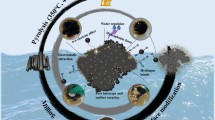Abstract
A novel biochar, whose precursor is popped rice, was produced to remove oil pollution in water. Popped rice biochar is characteristic with large pores. When popped rice was carbonized at 300 °C, its oil absorption capacity for paraffin oil is up to 10.88 ± 0.51 g/g, being much higher than that of the original popped rice (4.03 ± 0.39 g/g). In order to improve the oil-water separation property of popped rice biochar to absorb oil selectively, epoxy resin was used as a binder to make superhydrophobic SiO2 coated on the surface of popped rice biochar. The water contact angle of superhydrophobic SiO2 / popped rice biochar is 153 ± 0.9°, and it has good oil-absorption capacity with low water-absorption ratio. As the oil-absorption material is environmentally friendly, it will be a good select for the removal of oil pollution.
Similar content being viewed by others
Data Availability
All data generated or analysed during this study are included in this published article.
References
Wahi R, Chuah LA, Choong TSY, Ngaini Z, Nourouzi MM (2013) Oil removal from aqueous state by natural fibrous sorbent: An overview. Sep Purif Technol 113:51–63
Tornero V, Hanke G (2016) Chemical contaminants entering the marine environment from sea-based sources: A review with a focus on European seas. Mar Pollut Bull 112(1–2):17–38
Jawad LA, Ibrahim M (2018) Environmental oil pollution: a possible cause for the incidence of ankylosis, kyphosis, lordosis and scoliosis in five fish species collected from the vicinity of Jubail City, Saudi Arabia, Arabian Gulf. Int J Environ Stud 75(3):425–442
Qing Yun L, Liang Yuan Z, Lin L, Min W, Zhuo H (2014) Review of emergency treatment technologies for sudden water pollution accidents. J Yangtze River Scientific Res Inst 31(4):6–11
Kurtz RS (2004) Coastal oil pollution: spills, crisis, and policy change. Rev Policy Res 21(2):201–219
Koushkbaghi S, Jamshidifard S, Zabihisahebi A, Abouchenari A, Darabi M, Irani M (2019) Synthesis of ethyl cellulose/aluminosilicate zeolite nanofibrous membranes for oil–water separation and oil absorption. Cellulose 26(18):9787–9801
Barbara M, Tomasz B (2016) Organically modified zeolites in petroleum compounds spill cleanup — Production, efficiency, utilization. Fuel Process Technol 149:153–162
Guo D, Chen J, Hou K, Xu S, Cheng J, Wen X, Wang S, Huang C, Pi P (2018) A facile preparation of superhydrophobic halloysite-based meshes for efficient oil–water separation. Appl Clay Sci 156:195–201
Fragouli D, Athanassiou A (2017) Oil spill recovery: Graphene heaters absorb faster. Nat Nanotechnol 12(5):406–407
Medeiros MDA, De Oliveira DL, Sansiviero MTC, Araujo MH, Lago RM (2009) Use of the glycerol by-product of biodiesel to modify the surface of expanded vermiculite to produce an efficient oil absorbent. J Chem Technol Biot 85(4):447–452
Feng J, Nguyen ST, Fan Z, Duong HM (2015) Advanced fabrication and oil absorption properties of super-hydrophobic recycled cellulose aerogels. Chem Eng J 270:168–175
Duan Y, Bian F, Huang H (2016) Facile fabrication of porous oil-absorbent microspheres with high oil absorbency and fast oil absorption speed. Polym Advan Technol 27(2):228–234
Keshawy M, Abdulraheim AM, Kabel KI, Elkafrawy AF, Elmoghny TA (2017) Synthesis, characterization, and evaluation of polymeric oil sorbent for remediation of hydrocarbons spillage. J Disper Sci Technol 38(5):729–736
Turco A, Malitesta C, Barillaro G, Greco A, Maffezzoli A, Mazzotta E (2015) A magnetic and highly reusable macroporous superhydrophobic/superoleophilic PDMS/MWNT nanocomposite for oil sorption from water. J Mater Chem A 3(34):17685–17696
Tao M, Niu JT, Jin BD (2011) New oil-absorbent fiber absorb the oil of water. Adv Mater Res:2860–2866
Zhao MY, Cui YB, Li X, Liu YH, Li HX (2013) Study on purification of oil-polluted sea water by rice hull adsorbent. Appl Mech Mater:1245–1248
Proctor A, Gnanasambandam R (1997) Soy hull carbon as adsorbents of crude soy oil components: Effect of carbonization time. J Am Oil Chem Soc 74(12):1549–1552
Yang S, Chen L, Mu L, Hao B, Ma P-c (2015) Low cost carbon fiber aerogel derived from bamboo for the adsorption of oils and organic solvents with excellent performances. Rsc Adv 5(48):38470–38478
Stefelová J, Slovák V, Siqueira G, Olsson RT, Tingaut P, Zimmermann T, Sehaqui H (2017) Drying and pyrolysis of cellulose nanofibers from wood, bacteria, and algae for char application in oil absorption and dye adsorption. Acs Sustain Chem Eng 5(3):2679–2692
Kandanelli R, Meesala L, Kumar J, Raju CSK, Peddy VCR, Gandham S, Kumar P (2018) Cost effective and practically viable oil spillage mitigation: Comprehensive study with biochar. Mar Pollut Bull 128:32–40
Nguyen HN, Pignatello JJ (2013) Laboratory tests of biochars as absorbents for use in recovery or containment of marine crude oil spills. Environ Eng Sci 30(7):374–380
Kizil R, Irudayaraj JMK, Seetharaman K (2002) Characterization of Irradiated Starches by Using FT-Raman and FTIR Spectroscopy. J Agr Food Chem 50(14):3912–3918
M I (2000) New Carbons - Control of structure and functions. Elsevier Sci:124–145
Jiang YF, Sun H, Yves UJ, Li H, Hu XF (2016) Impact of biochar produced from post-harvest residue on the adsorption behavior of diesel oil on loess soil. Environ Geochem Hlth 38(1):243–253
Funding
This work was supported by the National Natural Science Foundation of China (Grant No. 51003030).
Author information
Authors and Affiliations
Contributions
Ying Jiang provide Superhydrophobic SiO2 and coating method, Xiaoye Huang prepared the popped rice biochar and analyzed the data, and was a major contributor in writing the manuscript. All authors read and approved the final manuscript.
Corresponding author
Ethics declarations
Conflict of Interest
The authors declare that they have no conflict of interest.
Rights and permissions
About this article
Cite this article
Huang, X., Jiang, Y. & Yu, R. Popped Rice Biochar and Superhydrophobic SiO2 / Popped Rice Biochar for Oil Adsorption. Silicon 13, 2661–2669 (2021). https://doi.org/10.1007/s12633-020-00621-z
Received:
Accepted:
Published:
Issue Date:
DOI: https://doi.org/10.1007/s12633-020-00621-z




